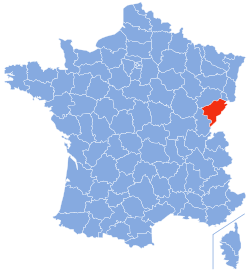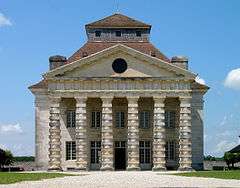Doubs
| Doubs | |||
|---|---|---|---|
| Department | |||
|
Prefecture building of the Doubs department, in Besançon | |||
| |||
 Location of Doubs in France | |||
| Coordinates: 47°10′N 06°25′E / 47.167°N 6.417°ECoordinates: 47°10′N 06°25′E / 47.167°N 6.417°E | |||
| Country | France | ||
| Region | Bourgogne-Franche-Comté | ||
| Prefecture | Besançon | ||
| Subprefectures |
Montbéliard Pontarlier | ||
| Government | |||
| • President of the General Council | Claude Jeannerot (PS) | ||
| Area1 | |||
| • Total | 5,234 km2 (2,021 sq mi) | ||
| Population (2013) | |||
| • Total | 533,320 | ||
| • Rank | 50th | ||
| • Density | 100/km2 (260/sq mi) | ||
| Time zone | CET (UTC+1) | ||
| • Summer (DST) | CEST (UTC+2) | ||
| Department number | 25 | ||
| Arrondissements | 3 | ||
| Cantons | 19 | ||
| Communes | 585 | ||
| ^1 French Land Register data, which exclude estuaries, and lakes, ponds, and glaciers larger than 1 km2 | |||
Doubs (French pronunciation: [du]; Arpitan: Dubs) is a department in the Bourgogne-Franche-Comté region of eastern France named after the Doubs River.
History
As early as the 13th century, inhabitants of the northern two-thirds of Doubs spoke Franc-Comtois, a dialect of Langue d'Oïl. Residents of the southern third of Doubs spoke a dialect of the Arpitan language. Both languages co-existed with French, the official language of law and commerce, and continued to be spoken frequently in rural areas into the 20th century. They are both still spoken today but not on a daily basis.
Doubs was important as a portal to Switzerland through the pass at Joux. Many famous people, including Mirabeau, Toussaint Louverture and Heinrich von Kleist, were imprisoned in the Château de Joux.
Doubs is one of the original 83 departments created during the French Revolution on 4 March 1790. It was created from part of the former province of Franche-Comté. The prefecture (capital) is Besançon.
In 1793, the republic of Mandeure was annexed by France and incorporated into the department. This district was passed between various territories and departments in the ensuing administrative reorganisations and wars, but was restored to Doubs in 1816 when the former principality of Montbéliard was also added to the department.
However, the commune of Le Cerneux-Péquignot was annexed by the Canton of Neuchâtel under the terms of the 1814 Treaty of Paris, and since remained Swiss territory.
Between the defeat of France at the Battle of Waterloo and November 1818, Doubs was included in the area occupied by Austrian troops.
Victor Hugo, Gustave Courbet, and Auguste and Louis Lumière are among the famous people born in Doubs.
Geography
Doubs is part of the current region of Bourgogne-Franche-Comté and is surrounded by the French departments of Jura, Haute-Saône, and Territoire de Belfort, and the Swiss cantons of Vaud, Neuchâtel, and Jura.
The department is dominated by the Jura mountains, which rise east of Besançon.
Politics
The President of the General Council is Claude Jeannerot of the Socialist Party.
| Party | seats | |
|---|---|---|
| • | Socialist Party | 16 |
| Union for a Popular Movement | 13 | |
| • | Miscellaneous Left | 3 |
| Miscellaneous Right | 2 | |
| MoDem | 1 | |
| • | The Greens | 1 |
Demographics
The inhabitants of the department are called Doubistes.
Economy
The Doubs department is at the same time the greenest and the most industrialized in France.
It is the birthplace of the automotive manufacturer Peugeot.
Tourism
The castle of Joux and Besançon are important tourist destinations.
Gallery
See also
- Arrondissements of the Doubs department
- Cantons of the Doubs department
- Communes of the Doubs department
Bibliography
| Wikisource has the text of the 1911 Encyclopædia Britannica article Doubs (department). |
- Hoffmann, Michael, Die französischen Konservativen in der katholischen Provinz Parteigenese und politische Kultur im Doubs (1900-1930) (Frankfurt am Main u.a., Peter Lang, 2008) (Moderne Geschichte und Politik, 22).
External links
- (French) Prefecture website
- (French) General council website
_(adjusted).jpg)



